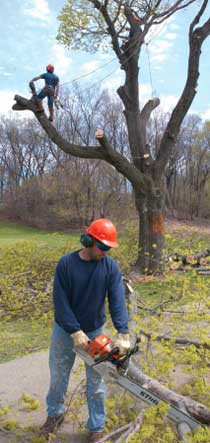Parks & Recreation 2002-2003 Biennial Report
Eight Seasons of Progress
Parks People

- An average of $262 million was allocated annually to Parks & Recreation for equipment and 8,000 personnel.
- Parks & Recreation was awarded more than $79 million in federal and state grants in 2002 and 2003.
- Parks & Recreation concessionaires, ranging from hot dog vendors to golf course operators, paid $113 million in fees to the city over the last two years – up $10 million from the previous biennial period.
ALL OF PARKS & RECREATION is divided into four parts. One maintains and operates our parks, another programs and patrols them, the third builds them, and the fourth manages and enhances agency resources. This team, 8,000 strong at its summer peak, has invigorated our parks and programs over the past two years.
OPERATIONS
Our Operations division ensures that 1,700 parks, more than 2,050 green-streets, and 14 miles of beaches are clean, safe, and accessible. This division includes nearly 3,000 year-round employees and 3,000 participants in our Parks Opportunity Program (POP), which helps public assistance recipients gain full-time employment. In 2002 and 2003, we wired our district offices for email access and equipped supervisors with point-to-point radios to quicken internal communication. To improve community outreach and park management, we created two new park administrator positions: one for northern Manhattan and another for northeastern Queens. We acquired 100 acres for the next generation of New York City parks.
Managing parks is vital work, and New York City has the best staff to do it. Recognized nationally for their innovative practices, our workers and nonprofit partners bring talent and passion to the job. I have loved being part of this agency for the last 25 years.
-Adrian Benepe, Parks & Recreation Commissioner
PUBLIC PROGRAMS
Our Public Programs division was created in 2002, linking recreation, enforcement, outreach, and environmental education; it has become the most progressive arm of the agency. Our Parks Enforcement Patrol has been working more closely with local police precincts to make parks safer. Our outreach coordinators cultivated new volunteer groups. We integrated Parks Central Communications with the city’s 311 non-emergency hotline, enabling us to respond more expeditiously to our patrons’ concerns.
CAPITAL
Our Capital division is regarded as a national leader in playground and park design. Staffed with architects, engineers, landscape designers, lawyers, and technicians, we directed the investment of $350 million over two years into park construction and refurbishment. To increase the productivity of our Capital division, we reorganized the staff into borough teams, unifying designers and construction supervisors to work on borough-specific projects. Modeled after a collaborative method common in the private sector, this system has improved communication both within the division and between Capital and borough administrative offices.
MANAGEMENT

Our Management division oversees and enhances agency resources. It serves as our internal auditor and park inspector. Over the past two years, we boosted our annual inspections by 25 percent to 5,000, and we increased concession revenue by 9 percent. We integrated our geographic data through a computer mapping system. Most importantly, we reorganized our job training and job placement program for POP participants. In the two years covered by this report, we helped more than 1,000 participants find permanent jobs.
LOOKING AHEAD
As part of Mayor Bloomberg’s effort to provide a seamless delivery of city services, we are developing youth programs together with other agencies and non-profits. Throughout the agency, we will adopt more environmentally friendly policies, reducing energy consumption in our buildings, using green designs in construction projects, and purchasing more low-emission vehicles for our fleet.
